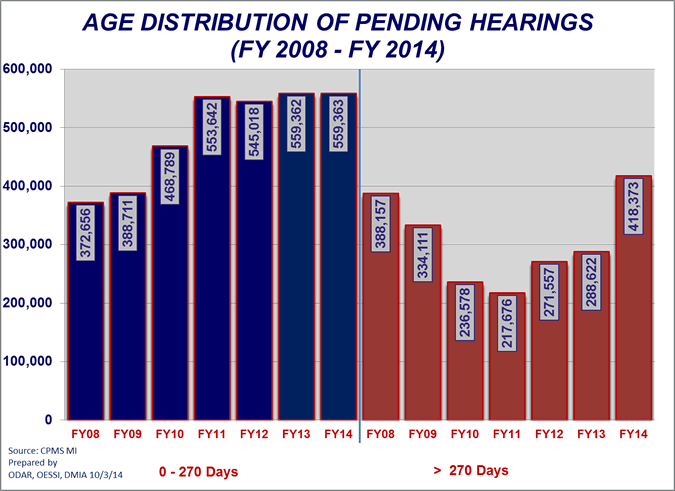SSDI Hearings Running Behind
Although the Veterans Affairs (VA) and the Patent Office are infamous among federal agencies for the long wait times and lines, their backlogs pale in comparison to another office that manages court hearings for the Social Security Disability Insurance (SSDI) program. According to an article by David A. Fahrenthold from the Washington Post, with 990,399 people waiting to get a decision on their disability claims, “That is Washington’s backlog of backlogs — a queue of waiting Americans larger than the populations of six different states.” In contrast, the VA has 526,000 cases pending and the Patent Office has 606,000 applications waiting.
The Social Security’s old age program uses a very clear, measurable standard to award benefits: the Full Retirement Age. Determining eligibility is easy, since it is purely based on your age.
Conversely, determining if a worker is eligible for SSDI benefits is not as simple. To qualify for benefits, insured workers have to suffer from one or a combination of physical impairments that render them unable to perform any job available in the economy. This requires medical evidence, a complex set of guidelines, and government employees who make determinations whether a person is disabled.
How is eligibility determined?
Individuals first file an application with a state-run office, which collects their medical records and evaluates their potential to work and earn above a certain threshold ($1,070 per month for most people). For this, state employees use medical and occupational guidelines that help them make a decision. Rejected applicants can ask to be reconsidered, which repeats the process with a different state official. If the second person also denies benefits, the applicants can appeal for the chance to get an oral hearing in front of an Administrative Law Judge.
While the backlog for the initial phases are also long (reaching 642,127 in 2014 for the initial stage), the hearing stage has a much larger backlog and a longer average wait time. On average, applicants wait 422 days to get a decision from a judge. This is after waiting 109 days and 107 days for a decision on the first two stages of the process respectively.
This is partly because judges have to dedicate many hours to each case, seeking to understand the applicants’ level of pain, the severity of their medical condition, and their capacity to perform work. Some of these factors are highly subjective. Making a decision thus requires understanding hundreds of pages of medical evidence (not necessarily a judge's core strength), listening to the applicant’s testimony, and making a decision based on guidelines that many experts claim are outdated.
As Fahrenthold explains:
That is slow work, made slower by a pileup of outdated rules and oddball procedures. The judges’ official list of jobs, for instance, is a Depression-era relic last updated in 1991. It still includes “telegram messenger” and “horse-and-wagon driver” — not exactly growth industries. It doesn’t mention the Internet at all.
While internet-enabled jobs don’t make it into the occupational dictionary, occupations still listed include mule driver, circus train supervisor, seal killer (although the practice was outlawed in 1972), and calculating machine operator.
You read right, this is before the invention of the modern calculator.
Source: Hannes Grobe - Calculator triumphator hg CC BY-SA 2.5
What does this means for applicants?
The result is a lengthy process and a massive bureaucracy. While the VA and the patents offices have much longer average wait times (957 days and over 800 days respectively), the SSDI system is already devoting substantial numbers of judges to working through cases. Fahrenthold reports that:
There are 1,445 of these Social Security judges, which means its in-house legal system is larger than the entire regular federal court system — district and appeals courts and the Supreme Court put together.
What’s more, Fahrenthold explains that the wait for SSDI applicants is particularly onerous because they are not receiving any income in the meantime. As the following graph shows, the number of hearings pending for over 270 days (SSA's target) has been steadily increasing since 2011, effectively increasing the average time that applicants have to wait for a hearing.
Experts also complain that the complexity of the process and the pressure on judges to work through the backlog sometimes leads to unfair decisions. According to a report by SSA’s Inspector General, the percentage of cases approved widely varies by judge, ranging from 8.6 to 99.37 percent, even though each judge theoretically recieves similar cases.
The Road Ahead
The SSDI program is very important to millions of Americans workers who paid into the Social Security system and, faced now with a physical or mental impairment, collect benefits. As we have argued before, there are several areas of the program that could be improved to make the lives of people with disabilities better.
In just two years, Congress will need to consider the issue of the SSDI Trust Fund projected insolvency in 2016. That will present an opportunity to make improvements to the program. That's why former Congressmen Jim McCrery (R-LA) and Earl Pomeroy (D-ND) launched the McCrery-Pomeroy SSDI Solutions Initiative. The project is currently calling on experts to propose ideas on how to improve several aspects of the program.
Many of these proposals, such as ideas to simplify the determination process, update the eligibility standards, and other changes to help reduce the backlog, will have nothing to do with the program's financial difficulties. But they may have a big impact on the people waiting for a decision or those receiving benefits. Having well-vetted, practical policy ideas that address complex problems within the system will be critical to have an informed and constructive debate on SSDI as the 2016 deadline approaches.



